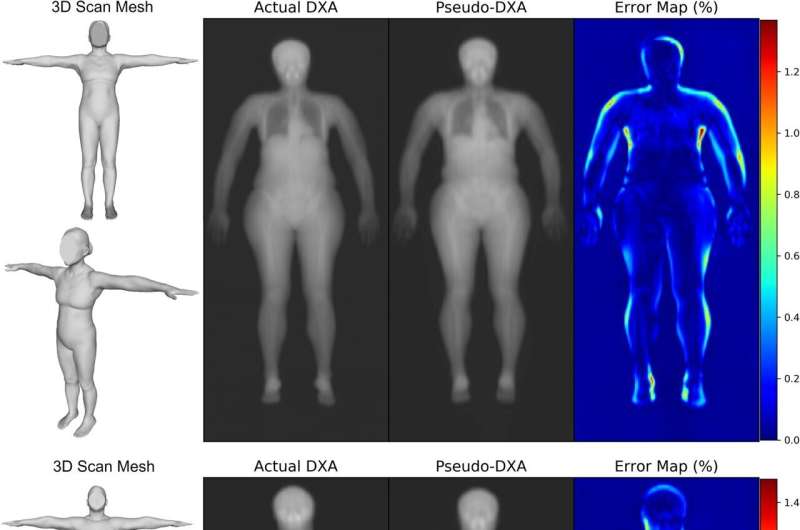This article has been reviewed according to Science X's editorial process and policies. Editors have highlighted the following attributes while ensuring the content's credibility:
fact-checked
trusted source
proofread
Researchers combine modern equipment for increased precision in body composition analysis

Locating specific, localized distributions of fat and muscle in body composition is intuitively and imprecisely implied by body shape. Now, a team of researchers has discovered that the unique combination of modern deep learning models, specified equipment and three-dimensional body scans has given a quantitative validation on medical imaging that was previously only qualitative.
Pennington Biomedical Professor of Metabolism and Body Composition Dr. Steven Heymsfield is part of a team of researchers who confirmed the results in the study "Generative Deep Learning Furthers the Understanding of Local Distributions of Fat and Muscle on Body Shape and Health Using 3D Surface Scans." The study appears in the Communications Medicine.
"To easily and quickly create a detailed digital map of a person's body shape and then to use that information to generate not only accurate estimates of their body composition and health risks, but also a corresponding X-ray image, was almost unimaginable just a few years ago," said Dr. Heymsfield. "Technological advances like this require skills from a broad range of scientists who make their academic homes at institutions like Pennington Biomedical and the University of Hawaii Cancer Center."
The research group used previously obtained 3D body surface scans, originally gathered from the "Shape Up! Adults" study, for which Pennington Biomedical was a participating clinical study site. The scans were taken with a 3D booth-based camera, originally designed for the clothing industry, but lately used more and more commonly with biomedical research. The team developed a model that fed the 3D surface scans into a dual-energy X-ray absorptiometry, or DXA scanner. With the inputs, the DXA scanner measured quantities of muscle, fat and bone.
The DXA scanner generated results showing where the distributions of fat and muscle were located, and the team then affirmed this accuracy with standard measurements using scales and measuring tape. When compared with commercial software that is commonly used in clinical settings, the team's unique combination of equipment and analysis yielded measurements of fat, lean muscle and bone with greater accuracy. Ultimately, the combination of these two pieces of equipment helped affirm the strong relationship between exterior body shape and interior composition.
"With our goal of contributing to the knowledge base, even the pairing of two extensively tested pieces of equipment is opening doors to profound body measurement possibilities that are both accurate and noninvasive," said Dr. John Kirwan, Executive Director of Pennington Biomedical. "This study is the latest in Dr. Heymsfield's long legacy of technological advancements in pursuit of improvements to health, including his work with the latest digital health and wellness tools, which he undertook in 2021 when he was named an Amazon Scholar."
With the accuracy of this method confirmed, Dr. Heymsfield is confident about how this sort of scanning may be used. Stating that the key benefits are how accurate and noninvasive this measurement method is, he predicts that such methods will be used in the measurement of sarcopenia, or the age-related involuntary loss of muscle mass and strength.
More information: Lambert T. Leong et al, Generative deep learning furthers the understanding of local distributions of fat and muscle on body shape and health using 3D surface scans, Communications Medicine (2024). DOI: 10.1038/s43856-024-00434-w





















